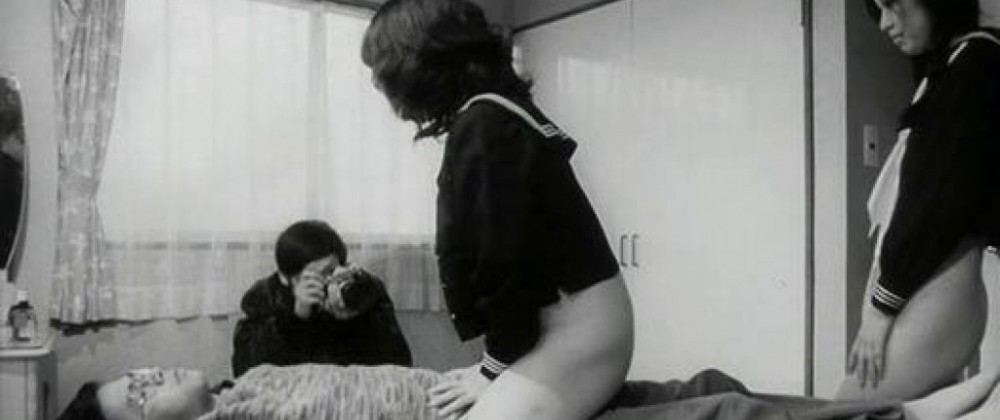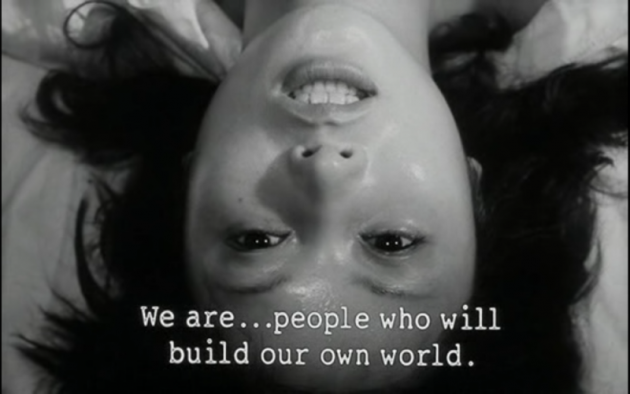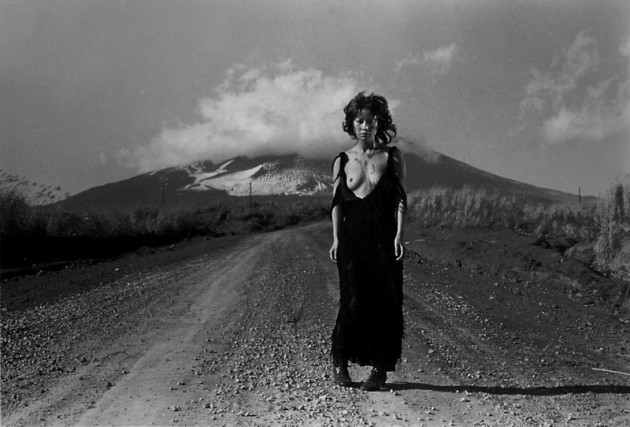Koji Wakamatsu: Sex is Politics 24 Times a Second

Koji Wakamatsu is often called the “Godfather” of Pinku, a genre of erotic cinema that flourished in Japan from the late 1960s through to the 1990s. The young ex-con and former yakuza enforcer started producing work in the mid-60s at an astonishing rate of more than 20 films in three years, when the genre was still ill-defined and before the big studios turned to it to reverse their failing fortunes in the 1970s. His work distinguishes itself from the rest of the films of that period in a number of ways. Wakamatsu’s films are easily recognizable not only for their endless experimentation with form, but also for their highly political content. The 60s were a particularly eventful period for Japan, with widespread protests against the American military presence marking the emergence of a new generation influenced by American values and the wealth of the post-war “economic miracle.” Much of that political content, often bracingly critical of Japanese society, is communicated through the overflowing sexuality of the films. The harsh criticism of Japan sometimes extends to scenes where rape and sexual violence are used as metaphors for everything from the American military presence to the oppressive constraints of society. These moments can be dismissed as mere misogyny, but that would mean disregarding the very real and potent political critique those films contain. The purpose of this essay is not to “rescue” those movies, but to bring to light, through a rigorous understanding of the socio-political context they emerged from and engaged with, and pointed formal analysis, the (still) revolutionary, vital and transgressive nature of Wakamatsu’s work.

Japanese sex with Stalin as voyeur in Secrets Behind the Walls
These movies had their detractors, most famously Donald Ritchie, who argued that Wakamatsu made “embarrassing soft-core psychodrama,” and that Noel Burch had mysteriously persuaded the French into seeing “great cinematic depth” in Wakamatsu’s Violated Angels (1967). Ritchie continued: “It occurs to no-one that the reason for making it was non-cinematic. So Koji was treated like his junk meant something” (Neech). This is a position which seems to reduce the films to the functions of their genre in order not engage with them. Wkamatsu’s pinku films have also gained a number of defenders, such as the critics Go Hirasawa and Alberto Toscano, who seem to want to elevate his work over their genre trappings. This is not my purpose. I believe the genre and its spectatorship was central to Wakamatsu’s work, both in how he dealt with abject sexuality and how it afforded him freedom to experiment. The films are Pink films, and this is not a bad word. To make this argument, this essay will use Wakamatsu’s Secrets Behind the Walls (1965) and Ecstasy of the Angels (1972) as case studies.
When talking of Wakamatsu, it is essential to start by discussing the context from which his films emerged. It seems almost too easy to reduce an oeuvre to the high points of its author’s life, but Wakamatsu’s biography differs strongly enough from the typical narrative of Japanese filmmakers of the time (film school, then assistant director, then rebellion, then New Wave) to warrant a mention. Born in 1936 in Wakuya, a small town in northern Japan, Wakamatsu is Burakumin, a member of an oppressed social caste in Japan roughly equivalent to India’s “untouchables.” Already outcast from mainstream society, Wakamatsu joined the yakuza at a young age and began to work as “security” on film shoots. From there, he decided to jump into directing low-budget Ero-duction (erotic education) films, growing more and more as an artist until his international breakthrough, after about 20 films since 1963, at the 1965 Berlin Film Festival with Secrets Behind the Walls, a film the Japanese government deemed a “national disgrace” (Neech). He then moved further from his exploitative early films towards a more ambitious, experimental and radically political cinema.

Hot sex meets radical politics in Ecstasy of the Angels
Radical politics was in the air, with the 1960s emerging as one of the most politically tumultuous periods in Japanese history. As in the West, a new, politicized generation started making its voice heard, with the most extreme example being student riots mostly targeted at the renewal of the American military presence on Japanese soil. The young generation found itself torn between two poles. Following the end of World War II and the dropping of two atomic bombs, Japan was a nation in crisis, wounded and confused. America imposed a new set of values centred on individualism and capitalism through its hegemonic influence in most spheres of society. At the same time, traditional Japanese values which emphasized the group before the individual and championed subservience to authority became taboo for fear of a return to the dark days of Japanese imperialism. Out of this tension emerged a radical left which can be seen as a rejection of Western values and a return towards prizing the group in the form of class unity. At the same time, the post-war economic miracle was rapidly creating an affluent middle class which would split the difference between Western and Japanese values after the failure of the radical left movement in the early 1970s.
Concurrent to this, a new market for more sexually explicit films emerged as a result of relaxed censorship in the form of Ero-duction films, a precursor to Pink cinema. Wakamatsu stands as a synthesis of those two strands, allying political commentary with explicit sexual content to document and capture the troubled younger generation. His films also pitched themselves to this same audience by walking a thin line between exploring the complicated sexuality of Japanese audiences and fuelling it. In that sense, when I use “we” from now on, it must be understood as referring to both the contemporary author and reader of this essay and the audiences who saw the films upon their release. When looking at those movies, it is extremely important to keep in mind the intended audience, chiefly sexually-minded men who would likely have knowledge of the political climate Wakamatsu references.
These films were, in fact, intended for a primarily male audience both in their distribution through private theatre chains and in the types of sexuality they catered to. Women in these films are typically raped and assaulted. They are often allowed to exact revenge, but that does not change the fact that, for most audiences, the main interest of these films lies in their prurient pleasure, pleasure that is more often than not gendered and violent. Do the films enact a different kind of politics for male and (potential) female viewers? The question is complicated by the intentionality of the author. Is Wakamatsu using the trappings of the genre to deliver his political messages, half-heartedly including sex scenes to draw in audiences only to spring on them his revolutionary rhetoric, or is he more complicit in the representation of sexual violence? Does that attitude taint his message? Can he be genuinely revolutionary while still promoting a sexuality that appears to reaffirm patriarchy?
The need to engage with the realities of viewership these films operated under is exacerbated by the films’ relatively clandestine nature. They weren’t meant to get out of Japan; they were meant to stay a dark little secret, shown in private theatres for knowing audiences. Why else would the government so swiftly label them a “national disgrace”? In a way, their positioning as “shameful” can tell us more about the society that repudiates them and the people that seek them out than state-sanctioned “tasteful” fare. But to access this knowledge, a strong understanding, and in some way empathy for, the audience is a necessity. These films present a world in which sex, trauma and politics are inseparable, so we must understand the people who willingly enter that space.
Wakamatsu’s first internationally recognized film stands as a perfect encapsulation of this project. Secrets Behind the Walls engages with the political situation and complicated sexuality of its characters to create a bracing portrait of a generation torn between a violent past and an unwanted future. This complicated relationship to the past is made explicit in a sex scene which foregrounds Wakamatsu’s metaphorical handling of sexuality. The subtext here is blunt. A woman has sex with an atomic bombing survivor, her hands lingering on his wounded flesh as a picture of Stalin in the background looks on approvingly. Sex, war, trauma and politics are all intermingled, painting a complex picture of a wounded sexuality. Then, as the woman reaches orgasm in facial close-up, footage of the atomic bombing of Hiroshima and student protests are superimposed, explicitly linking her sexual pleasure to the political situation. Contradictory as it may seem, the characters get sexual enjoyment out of this intermingling of unfathomable atrocity and radical politics. Wakamatsu visually expresses the troubled and wounded sexuality of his generation, a bizarre triangle of sex, violence and politics.

Politicized orgasm in Secrets Behind the Walls
The integration of footage of student protests also showcases Wakamatsu’s growing alignment with the politics of the radical left, which becomes more pronounced in later films such as The Embryo Hunts in Secret (1966) or Violated Angels, both of which use the metaphor of violence against women to criticize the oppressive nature of authority. The Wakamatsu behind Secrets Behind the Walls hasn’t yet found a “solution,” or at least a movement to attach his revolutionary energy onto. At this point, he is still documenting rebellion, in these cases acts of violence that explode at no particular target.
Wakamatsu uses a similar device to critique the heavy presence of American culture in Japan, illustrating its reach through the sexual fantasies of young men. In a scene where the main character pleasures himself, Wakamatsu cuts to a close-up of his orgasmic face upon which images of Western pornography are superimposed, formally expressing the contaminated sexual fantasies of Japanese youth. Borrowing Juana Maria Rodriguez’s matrix surrounding abject sexuality becomes useful in thinking through the complex interplay Wakamatsu creates. It also opens the possibility of a female audience who could take pleasure in the movies and perhaps more fully partake in the revolutionary project behind the films. Rodriguez, in trying to understand the pull of racially violent sexuality on Latina women, recognizes the power of the type of sexual fantasies that “mark us as improper sexual subjects of feminist politics” (152), but also exposes the possibilities of that reaction being a productive way to engage with systems of power.
Rodriguez’s ideas allow us to more fully engage with the complexity and fluidity of Wakamatsu’s use of sexuality, of the type of scenes “that etch their way into our psychic imaginaries, that slither into our most shameful fantasies” (153). This engagement with the audience’s sexual fantasies lends these films a peculiar and complicated power. Like the characters who wrestle with their sexualities on screen, Wakamatsu’s representation of sexualities impacted by the trauma of war and the clash of values is meant to create a feeling of the abject, which paradoxically pushes the viewer further towards visceral embodiment. Rodriguez further argues that abjection “also becomes the site through which the particularities of our material embodiments exert their most powerful influence, and exert it in a way that returns us to an encounter with our sensing bodies” (141). It is in this power relationship between the abject and the embodied experience that Wakamatsu attempts to articulate a political argument, not a stale and rigid message, but a complicated engagement with the oppressive systems of power which embed themselves in every part of the individual. Even when the trifecta of past, politics and sex is present in a single image, its delineation is as unclear and ever-changing on screen as it is in the minds of the viewers. There is no fixed position or hierarchy, each element contaminates and complicates each other like different liquids in a glass. Superimpositions, with their constantly morphing images, each movement creating a different interplay between layers, are a perfect formal representation of this.
However, Wakamatsu does not simply represent these realities; he forces us to engage with these images and to acknowledge our complicity in them. One of the ways in which he does this is by littering the film with voyeuristic imagery. One of the film’s main conflicts is centred around the main character’s voyeurism, his sexual frustration growing as he observes his neighbours’ love-making. However, he is not the only person in the film to exhibit such tendencies, with other characters peeping through curtains and letterboxes. The central scopophilia of cinema which Laura Mulvey isolated is shared in the diegesis of the film, furthering the identification between viewer and character and exposing us as a bearer of the gaze complicit in the acts of voyeurism.
Secrets Behind the Walls’ opening shot is a close-up of a woman’s eye staring directly at the camera, leading us to think that the film is as much watching us we are watching it. It is in this interplay between watcher and watched that Wakamatsu places the audience, making them engage with the sexual fantasies the film depicts on the one hand, but also reminding them of the real political forces at play behind them. The eye lets us know we are watched and at the film’s ending, it suddenly cuts to a newspaper headline reading “Housewife murdered in housing complex by high school student” and a radio blaring about a home run, reminding us of the reality of those images. We experience the fantasy, but have to emerge into the real world once the lights come back up. Wakamatsu merges sex and politics and forces us to understand our complicity and own complicated relationship to those subjects in Secrets Behind the Walls.

Ecstasy of the Angels
Seven years and multiple films later, in 1972, Wakamatsu has by this time quit the studio system following the disappointing domestic release of Secrets Behind the Walls (Nikkatsu Studios had preferred to sink the film to avoid the ire of the Japanese ratings board) and founded his own production company. He has become wary of the authoritarian tone the radical left has taken and has been forced to redefine his approach now that their project appears to be a failure. Nevertheless, Ecstasy of the Angels continues the revolutionary goals that run through his oeuvre, this time showcasing a a radically personal political view.
The film targets the power dynamics of radical left-wing movements, telling the story of a group of political activists who, after being betrayed by their leaders, devolve into paranoia, violence and sexual torture. The film extends its critique to any exercise of power, even that of the superficially “good” guys fighting for their beliefs. The film shows how even the revolutionary group uses the authoritarian tools of sex and violence to control their followers just as mainstream society does as in a scene where two characters are beaten and raped until they reveal where they are hiding their weapons. In previous films, the villains were conventional agents of power like the boss in The Embryo Hunts in Secret, but here Wakamatsu extends his critique to any institution contaminated by the paradigms of power.
Wakamatsu demonstrates the ways in which individuals absorb and regurgitate those structures of authority in the systemic breakdown of every character once the authority is shown to be unreliable. This is represented in multiple scenes where sex is used as a bargaining chip or to humiliate one another (in most instances men and women participate). Wakamatsu even seems to implicate himself in a scene where a lecherous photographer takes pictures of two women having sex in an apparent bid to anger another member of the group. In this world, everyone is trying to assert their authority over one another and to do so they use the very tools mainstream society uses to oppress people.
The film showcases Wakamatsu’s weariness with organized movements in the ways they perpetuate existing forms of power and oppression of individuals. The final scene is a wild stylistic sequence which can be read as the film destroying itself, with anything resembling a rule being broken. The message seems to be that if we exist in a world where oppression is inscribed everywhere, even in revolutionary art, then we might as well blow it up. Wild jazz plays and stops abruptly over shaky images of people running and explosions. The film cuts between images with no regard for coherence of time and space. This in a way is an encapsulation of his revolutionary philosophy, that the only true revolutionary ideal is an individual one. Ecstasy of the Angels cements Wakamatsu as an important voice of dissent and political commentary who followed his own muse whilst still recognizably working in the genre of Pink Cinema.
Wakamatsu’s films show a genuine political and formal authorship and are not simply cheap exploitation. In Secrets Behind the Walls, he uses the complicated sexuality of both his characters and his viewers to express his ideas about society and Ecstasy of the Angels expresses his true revolutionary ideals. This, however, does not divorce him from the genre he employs. Sex is an integral part of these films and so are the audiences who engage with them. Wakamatsu is a singular artist with a singular vision, but this is not an exception in the world of Pink cinema.
Bibliography
Mellen, Joan. The Waves at Genji’s Door: Japan through Its Cinema. New York : Pantheon Books. 1976. Print.
Neech, Dickon. “Koji Wakamatsu: The Rebellious Auteur” Eigagogo, n.d. Web. 09 Nov. 2015.
Nozaki Yoshiko. War Memory, Nationalism and Education in Post-War Japan, 1945-2007: The Japanese History Textbook Controversy and Ienaga Saburo’s Court Challenges. New York: Routledge, 2008. Print
Sato, Tadao. Currents in Japanese Cinema. New York: Berg. 2008. Print.
Sharp, Jasper. Behind the Pink Curtain: The Complete History of Japanese Sex Cinema. Godalming, Surrey: FAB, 2008. Print.
Toscano, Alberto, and Go Hirasawa. “Walls of Flesh: The Films of Koji Wakamatsu (1965–1972)”. Film Quarterly 66.4 (2013): 41–49. Web. 29 Nov. 2015.
Mulvey, Laura. “Visual Pleasure and Narrative Cinema.” Screen 16, no. 3 (September 21, 1975): 6–18.
Rodriguez, Juana Maria. “Latina Sexual Fantasies, the Remix.” In Sexual Futures, Queer Gestures, and Other Latina Longings, 139–82. New York: New York University Press, 2014.













